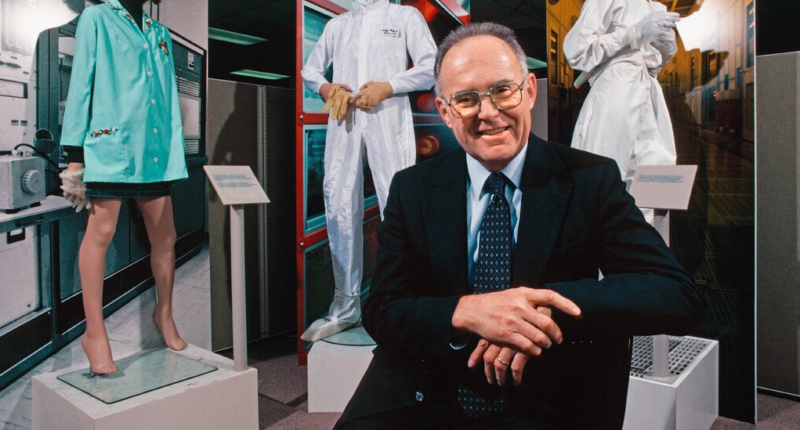Gordon Moore, the co-founder of Intel and the creator of Moore’s Law, passed away at the age of 92. Moore’s Law, which he came up with in 1965, predicted that the number of transistors that could be placed on a silicon chip would double at regular intervals, leading to the exponential growth of computing power. Moore’s predictions proved to be so reliable that the technology industry based their product strategy on the assumption that Moore’s Law would hold. He was instrumental in the development of silicon microprocessors that enabled American manufacturers to regain the lead in the computer data-processing field in the 1980s. Apart from his contributions to the technology industry, Moore was also a philanthropist who donated more than $5 billion through the Gordon and Betty Moore Foundation. Despite his enormous wealth, he remained unpretentious throughout his life. Moore’s Law is bound to reach its end, as engineers face some basic physical limits and the extreme cost of building factories to achieve the next level of miniaturization.
Gordon E. Moore: The Man Behind Moore’s Law and Intel’s Success
Gordon E. Moore, co-founder and former chairman of Intel Corporation, passed away at his home in Hawaii at the age of 94. His death was confirmed by Intel and the Gordon and Betty Moore Foundation, but no cause was specified.
Moore, along with a few colleagues, played a key role in transforming the microchip business into one of the world’s largest industries. By embedding microprocessors into various products such as cellphones, cars, and jets, he helped bring laptop computers to hundreds of millions of people.
An accidental entrepreneur, Moore became a billionaire due to an initial $500 investment in the fledgling microchip business. But it was his vision and prediction in 1965, which became known as Moore’s Law, that cemented his legacy. He predicted that the number of transistors on a silicon chip would double at regular intervals, thus increasing the data-processing power of computers exponentially. His corollaries were that the evolving technology would make computers more expensive to build but less expensive to purchase as so many would be sold. This law held up for decades.
Moore’s brilliance, leadership, charisma, and contacts, combined with his partner Robert Noyce, helped assemble a group widely regarded as among the boldest and most creative technicians of the high-tech age. The team advocated the use of silicon chips because of their ability to house smaller and smaller electronic circuitry that could work at higher and higher speeds.
Moore’s prediction charted a course for the age of high tech, giving Silicon Valley its name, and making it a dominant industrial player, once held by the giant American railroad or steel companies of another age.
Moore’s death marks the end of an era, but his legacy and contribution to the tech industry will continue to impact generations to come.
Gordon E. Moore: The Visionary Who Helped Make Computers Cheaper
Gordon E. Moore, the co-founder and former chairman of Intel Corporation, played a key role in enabling American manufacturers to regain the lead in the computer data-processing field from their Japanese competitors in the mid-1980s. He became the chief executive of Intel in 1975, a position he held until 1987 when Andrew Grove succeeded him. He continued to remain as the chairman of the company until 1997. Under his leadership, Intel’s silicon microprocessors, which serve as the brains of a computer, were placed in 80 percent of the computers being made worldwide by the 1990s, making it the most successful semiconductor company in history.
Moore’s Law was one of Mr. Moore’s most significant contributions to the tech industry. In 1965, he predicted that the number of transistors on a silicon chip would double at regular intervals, increasing the data-processing power of computers exponentially. Over time, the technology industry based their product strategy on the assumption that Moore’s Law would hold, and it proved to be reliable for decades.
Moore’s vision led to the development of microprocessors that enabled electronics to become cheaper over time, as the industry shifted away from discrete transistors and tubes to silicon microchips. Moore’s prediction was not only precise but was also a crucial factor in the success of the tech industry.
Aside from his contributions to the tech industry, Mr. Moore was also a notable figure in philanthropy. He and his wife created the Gordon and Betty Moore Foundation in 2001, with a donation of 175 million Intel shares. They also donated $600 million to the California Institute of Technology, which was the largest single gift to an institution of higher learning at the time. The foundation’s assets currently exceed $8 billion, and it has given away more than $5 billion since its founding.
Mr. Moore was born on January 3, 1929, in San Francisco and grew up in Pescadero, a small coastal town south of San Francisco. He attended San Jose State College and met Betty Whitaker, a journalism student, and they married in 1950. He completed his undergraduate studies in chemistry at the University of California, Berkeley, in 1950 and received his doctorate, also in chemistry, from Caltech in 1954.
Despite his impressive achievements, Mr. Moore remained characteristically humble about his technical advances, particularly those made possible by Moore’s Law. He saw semiconductor devices as a way to make electronics cheaper, and his prediction proved to be more precise than he had ever imagined. Moore’s Law may be his most significant contribution, as it led to significant advancements in computer technology, which continue to impact the world today.
Gordon E. Moore: The Accidental Entrepreneur
Gordon E. Moore, the co-founder and former chairman of Intel Corporation, was not always destined for a career in the tech industry. In fact, he wanted to become a teacher but was unable to get a job in education. After taking a position with the Applied Physics Laboratory at Johns Hopkins University in Baltimore, he later interviewed at Lawrence Livermore Laboratory in Livermore, Calif., but turned it down as he did not want to take spectra of exploding nuclear bombs.
In 1956, Mr. Moore joined William Shockley, a co-inventor of the transistor, to work at a West Coast division of Bell Laboratories. However, the company, Shockley Semiconductor, struggled under Dr. Shockley’s management, leading Mr. Moore and Robert Noyce to leave and join a group of defectors who became known as “the traitorous eight.” The group formed Fairchild Semiconductor Corporation, which became a pioneer in manufacturing integrated circuits.
In 1968, bitten by the entrepreneurial bug, Mr. Moore and Mr. Noyce decided to form their own company, focusing on semiconductor memory. They called their start-up Integrated Electronics Corporation, which they later shortened to Intel. With $2.5 million in capital, they wrote a vague business plan that said they were going to work with silicon and make interesting products.
The company’s success was not without its challenges. In the early 1970s, Intel missed the opportunity to manufacture a PC, which Mr. Moore partly blamed on his shortsightedness. However, the company’s 4000 series “computer on a chip” began the revolution in personal computers.
Mr. Moore’s prediction in 1965 that the number of transistors on a silicon chip would double at regular intervals, increasing the data-processing power of computers exponentially, became known as Moore’s Law. Over time, the technology industry based their product strategy on the assumption that Moore’s Law would hold, and it proved to be reliable for decades. His vision led to the development of microprocessors that enabled electronics to become cheaper over time, which contributed to the success of the tech industry.
Despite his success in the tech industry, Mr. Moore remained characteristically humble about his achievements. In interviews, he described himself as an “accidental entrepreneur” because he became a billionaire as a result of an initial $500 investment in the fledgling microchip business, which turned electronics into one of the world’s largest industries.
Mr. Moore’s success allowed him to become a major figure in philanthropy. In 2001, he and his wife created the Gordon and Betty Moore Foundation with a donation of 175 million Intel shares. They also donated $600 million to the California Institute of Technology, which was the largest single gift to an institution of higher learning at the time. The foundation’s assets currently exceed $8 billion, and it has given away more than $5 billion since its founding.
Despite starting his career with a failed attempt at becoming a manager with Dow Chemical, Mr. Moore’s accidental journey led him to become one of the most influential figures in the tech industry, and his legacy continues to impact the world today.
Gordon Moore, the co-founder of Intel and the creator of Moore’s Law, passed away on March 31, 2022, at the age of 92. His vision for the future of electronics paved the way for modern technology, and his technical advances made a lasting impact on the industry. Moore’s Law predicted that the number of transistors on a computer chip would double approximately every two years. In the mid-1980s, Intel’s silicon microprocessors helped American manufacturers regain the lead in the computer data-processing field. By the 1990s, Intel had microprocessors in 80% of the world’s computers, making it the most successful semiconductor company in history.
After joining William Shockley at Bell Laboratories in 1956, Moore co-founded Fairchild Semiconductor in 1957. He and Robert Noyce founded Intel in 1968, with Andrew Grove as the third employee. After considering various technologies, they settled on a new version of MOS technology, called silicon-gate MOS, which helped create an integrated circuit. With $2.5 million in capital, Intel quickly became a pioneer in manufacturing integrated circuits. The 4000 series “computer on a chip” revolutionized personal computers in the early 1970s, though Intel missed the chance to manufacture a PC.
Moore’s Law played a crucial role in the rise of personal computers, which he initially did not believe would have a place in the home. As the industry shifted away from discrete transistors and tubes to silicon microchips, the reliability of his prediction led technology firms to base their product strategies on it. According to Harry Saal, a longtime Silicon Valley entrepreneur, “Any business doing rational multiyear planning had to assume this rate of change or else get steamrolled.”
Moore and his wife created the Gordon and Betty Moore Foundation in 2001 with a donation of 175 million Intel shares. They donated $600 million to the California Institute of Technology in 2001, the largest single gift to a higher learning institution at the time. The foundation’s assets exceed $8 billion, and it has given away more than $5 billion since its inception. Moore was also known for his philanthropy and his unassuming nature, preferring khakis and tattered shirts to tailored suits.
Though Moore’s Law is bound to reach its end, as engineers encounter some basic physical limits, as well as the extreme cost of building factories to achieve the next level of miniaturization, Moore’s vision for the future of electronics will continue to have an impact on modern technology.
Don’t miss interesting posts on Famousbio










